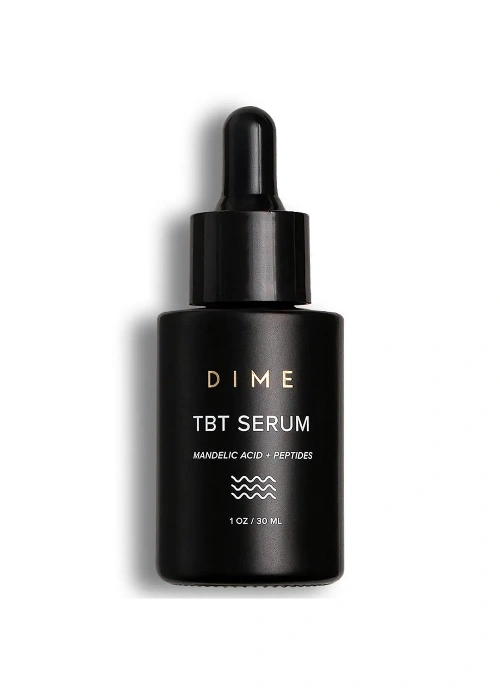Mandelic acid, a well-rounded, gentle, and intense exfoliating acid, is becoming increasingly popular in skin-care products. Known for its benefits since the late 90s it had been previously overlooked and it’s now being included in the latest serums and gentle liquid exfoliants for at-home use. Despite its popularity, mandelic acid is not only a common ingredient in in-office peels but also has its own unique benefits.
Ahead, read everything you need to know about mandelic acid.
What is Mandelic Acid?
Mandelic acid is an alpha hydroxy acid (AHA) derived from bitter almonds. Mandelic acid’s larger molecular size compared to glycolic acid makes it penetrate deeper into the skin more slowly (largely due to oil-soluble nature) and less likely to cause irritation. This physical characteristic makes chemical exfoliants more accessible to those with sensitive skin, making it a popular choice among dermatologists and consumers.
Mandelic acid is also a popular choice for darker complexions due to its non-melanotoxic nature, which doesn’t cause melanotoxicity or exacerbate discoloration. Instead, it helps reduce dark spots caused by acne or sun exposure. Mandelic acid peels are well-tolerated in color patients, with less risk of hyperpigmentation, photosensitivity, and scarring compared to glycolic acid.
What are the benefits of using mandelic acid on skin?
It’s gentle
Mandelic acid, being one of the largest AHAs, is known for its gentle skin properties, making it an ideal choice for those with sensitive skin due to its slower penetration rate.
Promotes collagen production
Mandelic acid enhances skin appearance by boosting collagen production, the primary protein in skin and connective tissue. The effects of mandelic acid vary, but some individuals experience a noticeable improvement in their complexion and appearance after a few weeks.
Uses of mandelic acid
Acne: Acne triggers skin oils, bacteria, dead skin cells, and inflammation. Mandelic acid-containing skin care products help regulate sebum production, unclog pores, and reduce inflammation, reducing acne breakouts. A study found a chemical peel with 45 percent mandelic acid was equally effective in mild to moderate acne, possibly more effective for inflammatory acne.
Hyperpigmentation: Research indicates that Mandelic acid may have lightening properties for dark spots, such as those in melasma, potentially reducing hyperpigmentation by up to 50% within 4 weeks.
Improves Skin texture: Mandelic acid’s exfoliating action effectively removes dead skin cells, resulting in firmer and smoother skin.
Anti-Aging: A 2013 study found that chemical peels with mandelic acid can stimulate collagen production, which decreases with age, reducing wrinkles and fine lines, resulting in a more youthful appearance.
How to Use Mandelic Acid
Mandelic acid can be added to your skincare routine, either morning or evening. Start with a nighttime serum containing mandelic acid, avoiding other AHAs, BHAs, or retinols. Gradually increase the frequency as your skin adjusts. AHA at night may be best due to increased sun sensitivity. Prioritize sunscreen to avoid sun damage. Be mindful of the concentration of mandelic acid in products, as higher concentrations may be more effective but may cause irritation. After exfoliation, use your preferred moisturizer to rehydrate and protect the skin barrier
How Does Mandelic Acid Compare to Similar Ingredients?
Mandelic acid is a milder alternative to glycolic acid and retinol due to its larger molecule size and slow penetration, making it a gentler choice. It offers similar benefits at a slower pace. Retinol, a concentrated derivative of vitamin A, offers similar benefits to AHAs, including collagen production, skin cell turnover, diminished fine lines, and clearer skin. Both ingredients can be used in-tandem, but for safety, start slowly and consult a dermatologist.
What Are the Downsides of Mandelic Acid?
Although it is a gentle topical acid, should be used with caution due to potential side effects like redness, peeling, and skin irritation. Overuse of alpha hydroxy acids can cause dermatitis and chemical burning. It is also important to note that sun protection is essential when using these ingredients, as they increase photosensitivity, making them particularly important for skin exfoliators.
Also invest in basic skin protection before using mandelic acid or its acidic relatives. Using moisturizer and SPF can reduce irritation and flakiness. Mandelic acid is also a good choice for those new to AHAs, BHAs, and PHAs, as it provides various benefits for everyone. However, it has drawbacks and should be used with caution.












